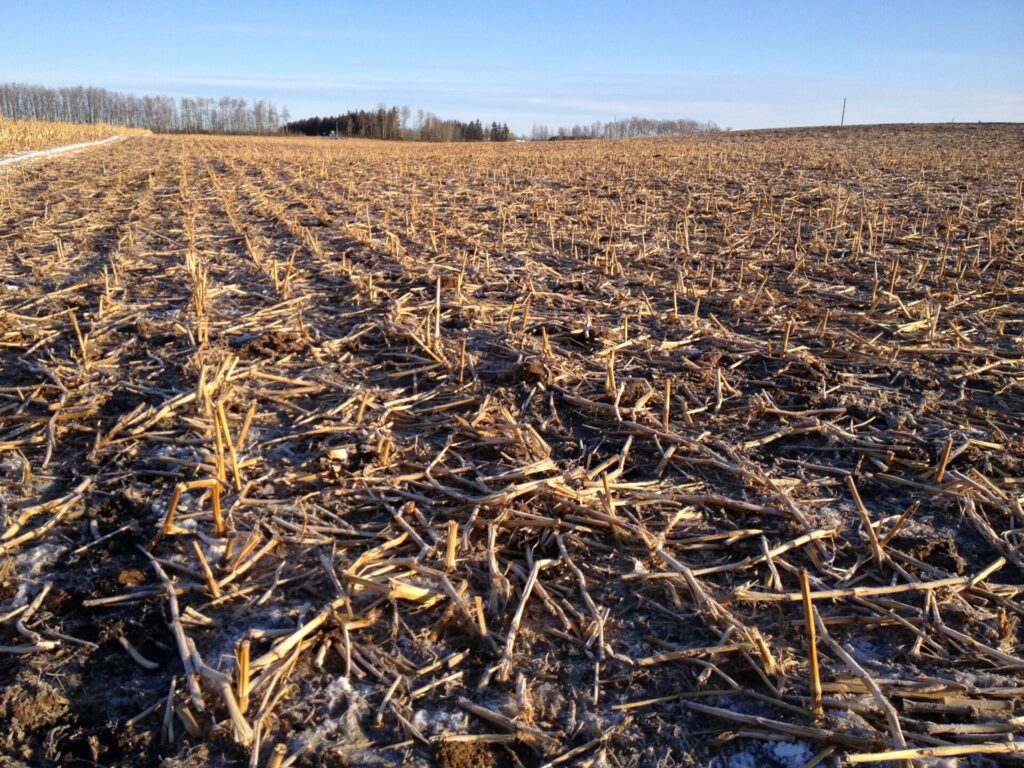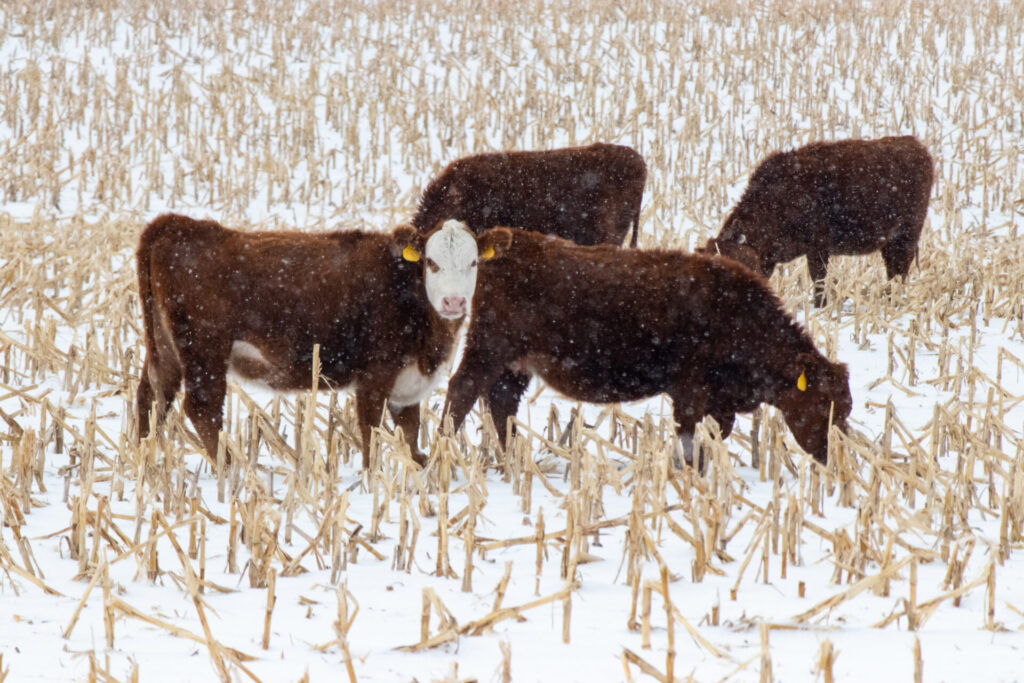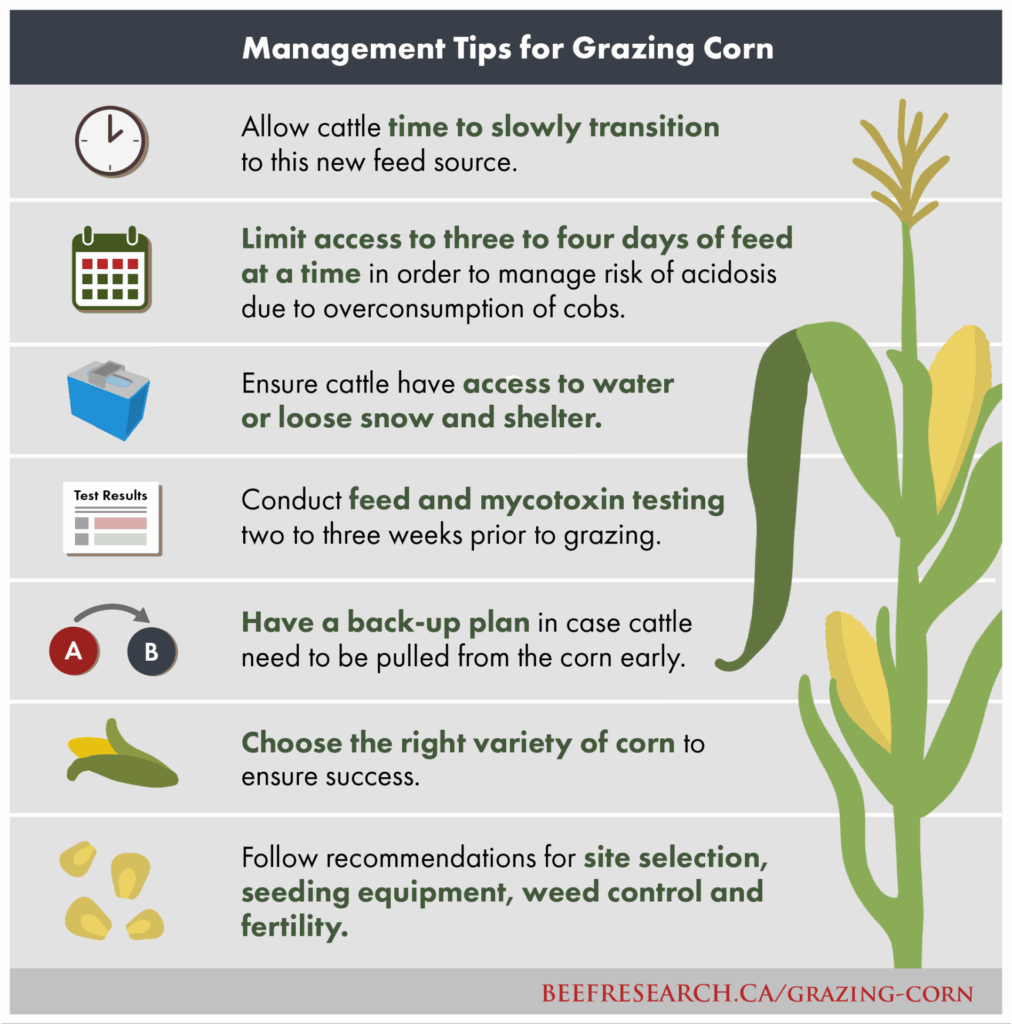Across Canada, more producers are turning to extended grazing systems throughout the year to reduce feed and labour costs. Grazing standing corn is one option being used by producers to extend the grazing season, supplement perennial pastures and increase overall carrying capacity. Corn is a high-energy, high-yielding crop that can produce large amounts of forage on a relatively small number of acres. The crop’s tall, upright growth structure makes it particularly accessible to cattle, even in deep snow. When managed well, corn grazing provides high energy, reduced reliance on harvested feeds and flexibility in winter grazing systems. It is, however, a relatively high-input, high-risk crop.


| Key Points |
|---|
| Grazing standing corn can extend the grazing season, reduce winter feeding costs and increase land-use efficiency. |
| It is a high-input, high-risk crop requiring careful variety selection, fertilizer management and weed control. |
| Early maturing silage-type hybrids with high biomass and moderate grain yield are preferred to minimize acidosis risk and improve feed quality. |
| Gradual transition and strip grazing using electric fences help manage intake, reduce waste and prevent digestive issues. |
| Protein and calcium may be deficient, so feed testing and supplementation are necessary. |
| Water and shelter are critical in winter conditions; standing corn can help protect cattle from wind and snow. |
| A backup feeding plan is essential in case of adverse weather or nutritional shortfalls. |
Why Graze Corn?
Standing corn offers a few benefits for winter grazing programs. As a warm-season crop, it yields more dry matter per acre than many other forages. Corn is also energy-dense, making it a suitable feed to meet the energy demands of cows in mid-gestation. When managed correctly, grazing corn can reduce winter feeding costs by eliminating the need for harvesting, hauling and feeding stored forages. In years of heavy snowfall, cattle may have better access to standing corn compared to swathed crops during storms.
Planning and Establishment
Successful production of corn is highly dependent on the availability of cold tolerant varieties, adequate heat units, fertilizer use and weed control. Select a variety that matches the Corn Heat Units (CHU) rating for your area to increase the chances of a high-yielding and high-quality corn crop. The CHU rating indicates the number of heat units required for the grain to reach maturity. Low heat unit varieties (less than 2100 CHU) have been developed in recent years. On average, 200 fewer CHUs are required for corn to reach a moisture level and maturity level considered favourable for grazing silage production as compared to grain production¹. Varieties that are early maturing silage-type hybrids with high biomass and moderate grain yield are preferred to improve feed quality.
Grazing corn can be seeded with an air seeder, air drill, row planter, or conventional hoe drill. Studies have shown there is an advantage to using a precision corn planter, when possible, to maximize biomass production¹. From Manitoba to British Columbia, the recommended seed depth is 1.5 to 2 inches deep, preferably into moisture, at a soil temperature of at least 10°C to germinate2. From Ontario to Prince Edward Island, the recommended seeding depth is into the moisture, from 1.5 to 3 inches deep. Row spacing of 30 inches is recommended to support plant development and cattle access.
Corn has a relatively high fertility requirement. Fertilizer rates of approximately 80 pounds of nitrogen per acre are typically required, but ultimately, application should be based on local soil test recommendations. Corn does not compete well with weeds, so controlling weeds in the early growth stages is critical. Producers should plan to treat fields before seeding and again at the 4-leaf and 8-leaf growth stages to manage weed pressure.
Preparing for Corn Grazing
Transitioning cattle onto corn should be done gradually. Whether it’s their first time or not, cattle need time to adapt both behaviorally and physiologically. Cattle unfamiliar with grazing corn may selectively consume only the cobs, leading to an increased risk of acidosis.

Water and shelter are critical components of any winter grazing system. Cattle should have access to clean water, whether from a dugout, flowing source or adequate snow. Standing corn may offer some protection from the wind during severe weather. Every degree below a cow’s lower critical temperature (LCT) (the temperature at which the maintenance requirements of the animal increase to the point that their performance is negatively affected) increases its energy requirement and thin animals (body condition score of 1-2) are more vulnerable to cold stress. Thin cows (BCS of 1.0 – 2.0) typically have a LCT of approximately -17oC, whereas cows in ideal condition (BCS of 3.0) have a LCT of approximately -25oC. Monitor body condition regularly and remove or supplement thin cattle as needed to maintain health and performance.
Animal Health and Nutrition
Corn can provide more than enough energy for cows in mid-gestation, but protein, calcium and other nutrients may be limited. Feed testing is essential to determine if additional supplementation is needed to meet the cattle’s nutritional requirements. Conduct feed and mycotoxin testing 2 to 3 weeks before grazing. Testing should be done close to grazing time to reflect what the animals will consume. Mycotoxins are a group of harmful toxins that can create a variety of problems for beef cattle, including impaired health and reduced productivity.
Mycotoxins are a “hidden hazard” and only detectable with lab testing. Learn more about feeding and testing for mycotoxins.
Research suggests that new cool-season corn hybrids can produce high-quality forage to meet the nutrient requirements of grazing beef cows in mid- and late-gestation, providing a suitable alternative for winter grazing strategies with forage harvest costs eliminated3,4. Other research suggests that intercropping corn with high-protein forage varieties such as clover, hairy vetch or Italian ryegrass can provide the dietary requirements for cows; however, further research is required on this strategy to determine a variety of factors.
There is no strong evidence that grazing standing corn causes lameness or foot issues when fields are well managed. However, the risk may increase if fields are muddy, icy, or if cattle must walk long distances between feed, water and shelter. In rare cases, frozen corn stalks can cause minor abrasions, but this is generally not a widespread concern.
Planning for the Unexpected
In years of heavy snowfall, standing corn has an advantage over swath-grazed crops, as cattle can more easily access the upright plant material above the snow line. Additionally, corn’s structure can reduce wind exposure, making it a valuable tool in winter grazing systems. Weather is a significant risk factor in any winter grazing system. Heavy snow, freezing rain, or early thaws can disrupt access to standing forage. Always have a backup plan in place, including alternative feed sources and the ability to bring cattle home if needed.
Producer Tips for Success
Some recommend starting small, planting just 5 to 10 acres to gain experience. Site selection is also important. Fields should have access to water, be sheltered, and be manageable for fencing and animal access. Gazing from the inside of the field outward can turn the corn stalks into a natural windbreak.
The BCRC post, Seven Tips for Grazing Corn, covers helpful practices including:
- allowing cattle time to transition to this new feed source,
- limiting feed access to prevent acidosis,
- protecting cattle from the elements,
- feed testing,
- having a back-up plan,
- planting for success.
Feedback
Feedback and questions on the content of this page are welcome. Please e-mail us at [email protected]
- References
-
1. Manitoba Agriculture, Food and Rural Initiatives. 2006. Grazing Cattle on Corn.
2. Manitoba Agriculture, Crop Management. Corn Seed Bed Preparation.
3. Lardner, H.A., L. Pearce, and D. Damiran. 2017. Evaluation of low heat unit corn hybrids compared to barley for forage yield and quality on the Canadian Prairies. Sustainable Agriculture Research. 6(1): 90-102.
4. Baron, V.S., H.G. Najda, D.H. McCartney, M. Bjorge, and G.W. Lastiwka. 2003. Winter weathering effects on corn grown for grazing in a short-season area. Can. J. Plant Sci. 83: 333-341.
Ce contenu a été révisé pour la dernière fois en Octobre 2025.